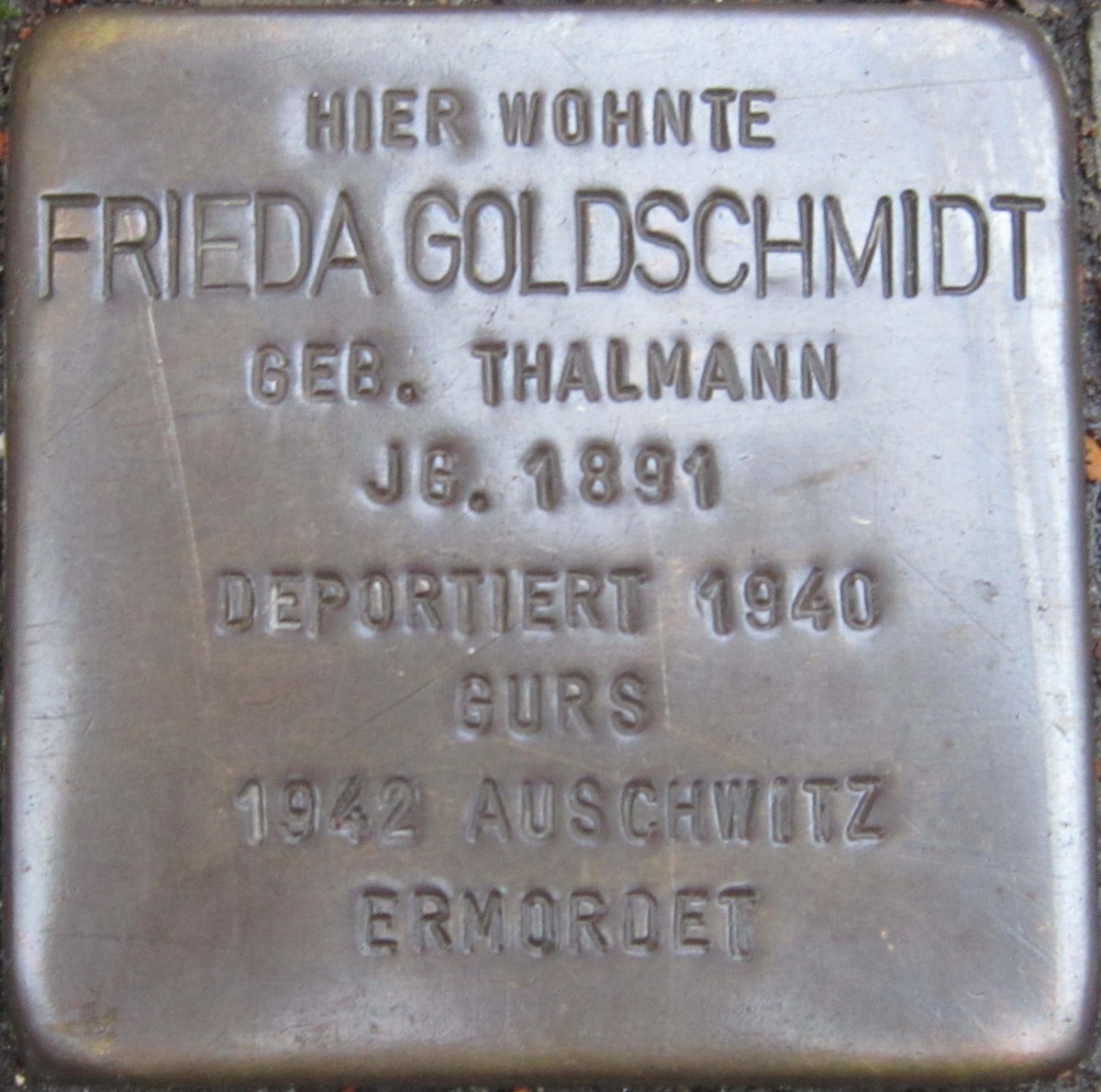
Stolperstein Frieda Goldschmidt Karlsruhe: Visiting Hours, Tickets, and Complete Guide
Date: 14/06/2025
Introduction
Visiting the Stolperstein dedicated to Frieda Goldschmidt in Karlsruhe, Germany, offers a powerful, personal connection to Holocaust history. This small brass plaque, set into the pavement outside Händelstraße 19—her last freely chosen residence—commemorates Frieda Goldschmidt, a victim of Nazi persecution. The Stolperstein is part of Gunter Demnig’s international Stolpersteine (“stumbling stones”) project, the world’s largest decentralized Holocaust memorial with over 100,000 stones across Europe (Stolpersteine.eu; Germany.info). This guide explores Frieda Goldschmidt’s story, the Stolpersteine project, practical visitor information, and the cultural significance of these memorials in Karlsruhe.
Table of Contents
- Frieda Goldschmidt and Her Family: Historical Background
- The Stolperstein for Frieda Goldschmidt: Location and Meaning
- Visiting Hours, Tickets, and Accessibility
- Stolpersteine Project: Origins and Significance
- Community Engagement and Educational Value
- Practical Visitor Tips
- Nearby Sites and Further Exploration
- FAQ
- Summary and Visitor Advice
- References and Resources
Frieda Goldschmidt and Her Family: Historical Background
Frieda Goldschmidt (née Thalmann), born in 1891, was part of Karlsruhe’s Jewish community. She lived at Händelstraße 19; her brother Max resided at Bismarckstraße 77—both locations now marked by Stolpersteine (Stadtwiki Karlsruhe; Stadtwiki Karlsruhe). With the rise of the Nazi regime, Frieda and her family faced persecution, forced displacement, and eventual deportation. Frieda was sent to Camp de Gurs and later murdered in Auschwitz (Gedenkbuch Karlsruhe).
The Stolperstein for Frieda Goldschmidt: Location and Meaning
The Stolperstein at Händelstraße 19 is a small, hand-engraved brass plaque bearing Frieda’s name, date of birth, fate, and place of death. As with all Stolpersteine, it is installed at the victim’s last self-chosen address, rooting memory in the community (Stolpersteine.eu). This micro-monument transforms everyday urban space into a site of remembrance and reflection, inviting passersby to “stumble” over the memory of an individual lost to the Holocaust (Folklife Magazine).
Visiting Hours, Tickets, and Accessibility
- Hours: Open and accessible 24/7. There are no specific opening or closing times.
- Tickets: No ticket or reservation is required; access is free.
- Accessibility: The Stolperstein is embedded at street level and is accessible to wheelchair users and those with limited mobility.
- Best Visiting Times: Daylight hours are recommended for visibility and safety. Early mornings or weekdays tend to be quieter.
Stolpersteine Project: Origins and Significance
Initiated by artist Gunter Demnig in 1992, the Stolpersteine project commemorates Holocaust victims by embedding individualized plaques at their last freely chosen residences (pragueviews.com). Each stone is inscribed with the words “Here lived,” the victim’s name, birthdate, fate, and, if known, date and place of death (atlasobscura.com). The metaphor of “stumbling” is intentional: while one does not physically trip, the stones are meant to catch the eye and conscience, prompting reflection (bbc.com).
With over 107,000 Stolpersteine across 31 European countries—including hundreds in Karlsruhe—the project’s scale reflects its resonance and the importance of decentralized, personal remembrance (stolpersteine.eu).
Community Engagement and Educational Value
In Karlsruhe, the Stolpersteine project is integrated into local memory culture and educational programs. Schools research the stories behind stones, and community members participate in cleaning and remembrance events on key dates such as International Holocaust Remembrance Day (January 27) and the anniversary of Kristallnacht (November 9) (BNN.de). These activities foster intergenerational dialogue and ensure that the lessons of the Holocaust remain present in public consciousness.
Practical Visitor Tips
- Finding the Stolperstein: Use the Stolpersteine Karlsruhe project website or the Stolpersteine Guide app for interactive maps and biographies.
- Tours: Guided and self-guided walking tours are available; check local resources or the Gedenkbuch Karlsruhe for schedules.
- Etiquette: Visit quietly and respectfully. It is customary to clean the plaque with a soft cloth or leave a small stone or flower—a gesture rooted in Jewish tradition.
- Accessibility: The site is wheelchair-accessible. Be mindful of surrounding pavement or curb height.
- Photography: Allowed, but please be considerate of local residents and pedestrian traffic.
- Recommended Attire: Wear comfortable walking shoes and bring weather-appropriate clothing.
Nearby Sites and Further Exploration
After visiting the Stolperstein for Frieda Goldschmidt, consider exploring other memory and heritage sites in Karlsruhe:
- Karlsruhe Palace and Museum: Learn about the city’s history.
- Karlsruhe Synagogue: A symbol of local Jewish heritage.
- Jewish Cemetery: Another significant site for reflection.
- Other Stolpersteine: Each stone tells a unique story; consult digital maps for locations.
FAQ
Is there an entry fee or ticket required?
No, visiting Stolpersteine is always free and open.
Are guided tours available?
Yes, local organizations offer both guided and self-guided tours. See the Stolpersteine Karlsruhe website.
When is the best time to visit?
The Stolperstein can be visited year-round, but daylight hours are recommended for visibility. Commemorative events on January 27 and November 9 offer a communal experience.
Is the site accessible for people with disabilities?
Yes, the plaque is at street level and accessible to all.
How do I find the Stolperstein?
Use the Stolpersteine Guide app or check the Gedenkbuch Karlsruhe.
Summary and Visitor Advice
The Stolperstein for Frieda Goldschmidt stands as a tangible link between past and present, personalizing the vast history of the Holocaust and making remembrance part of daily life in Karlsruhe. Its decentralized, accessible nature encourages every visitor to reflect, learn, and honor the victims of Nazi persecution. Enhance your visit by participating in local tours, engaging with educational resources, and exploring Karlsruhe’s broader historical landscape (Stolpersteine.eu; Folklife Magazine; Germany.info).
References and Further Resources
- Stadtwiki Karlsruhe - Stolpersteine Händelstraße 19
- Stadtwiki Karlsruhe - Stolpersteine Bismarckstraße 77
- Stolpersteine Karlsruhe Project
- Gedenkbuch Karlsruhe
- Stolpersteine.eu
- Atlas Obscura: Stolpersteine
- Folklife Magazine: Stumbling Stones
- BNN.de
- Germany.info: Stolpersteine
- Stolpersteine Guide App
- BBC Travel: Stolpersteine
- Prague Views: Stolpersteine
Images and virtual tours are available on the official Stolpersteine and Karlsruhe tourism websites. Use appropriate alt tags for accessibility, such as “Frieda Goldschmidt Stolperstein in Karlsruhe sidewalk.”
























































































































































































